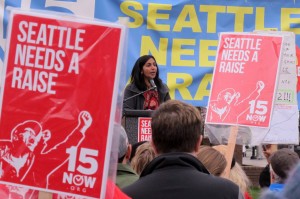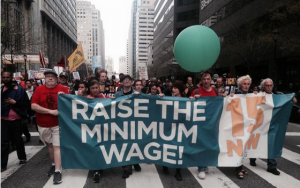Three years after New York fast food workers first went on strike demanding $15 an hour, cities and states across the country have significantly increased their minimum wages. These victories were given tremendous momentum by the historic impact of the $15 an hour struggle in Seattle in the Spring of 2014.
Like many other improvements in the lives of working people throughout the history of this country, these minimum wages had to be fought for, and anti-capitalists led the way. Nobody in Seattle’s halls of power were talking about a $15 an hour minimum wage until Socialist Alternative’s Kshama Sawant was elected in November of 2013. A few months later, they’d established the highest minimum wage in the country after multiple protests, neighborhood meetings, pickets and even strikes. In January, thousands of Seattle workers will get another raise on the path to $15 an hour.
After the Seattle victory, the labor movement across the country was encouraged to win the battle for wage increases. Also, many local politicians proposed enhanced minimum wage proposals in order to both build their electoral bases and sometimes to try to “cut off” the movement from growing and demanding more. New York, Chicago, Los Angeles, Washington DC and countless other cities have seen big improvements for low-wage workers. In 2016, the battles will go statewide in California and Oregon.
Historic Backdrop
Despite these victories, we should make no mistake about the overall situation–corporate America is still trying to make us pay for the crisis that their system created. They’re entrenching the “two tier” system of low wages for new hires in the auto industry. Big business is also still on the attack against public education, forcing the Seattle teachers to fight back and go on strike. Workers are showing a growing willingness to struggle, also reflected politically in electric support for Bernie Sanders’s message of “a political revolution against the billionaire class”.
Throughout the history of social justice struggles and the labor movement in this country, initial struggles led by anti-capitalists have given life to broader struggles of the working class. The mass “sit-down strikes” of the mid-1930s–which transformed labor relations in this country–were preceded by three strikes in 1934 led by anti-capitalists. The labor uprising of the 1970s was foreshadowed by the radicalism in the anti-Vietnam War movement, the civil rights movement and the black power struggle. The biggest strike wave in the history of this country (per capita), in the 1940s, came at a time of looming attacks on union rights, most notably the anti-labor Taft-Hartley Act against the right to strike.

Even when the bosses are on the offensive, we can fight back and win. The 15 struggle can pave the way for bigger movements of workers, youth and oppressed people.
What Now?
The coming wage increase in Seattle is a reminder of the struggle it took to win: electing working-class candidates and building grassroots mass movements with the support of union activists. In the week of November 10th and 12th, low-wage workers, unions and students across the country will once again raise 15 as part of a national day of action and a Million Student March, alongside demands for union rights, paid sick time and free public education.
The movement to increase minimum wages should link up with other struggles of working people–from battles to defend and extend public education to the Black Lives Matter movement. We should build on our strength and mobilize to win 15 in more cities and statewide in California and Oregon in 2016. These struggles, built through the grassroots methods advocated by 15 Now, can help working people gain the confidence they need to challenge other injustices of the system.
Re-Tweet this article to your followers:
Why are Seattle Workers Winning? https://t.co/skeUEfYF8Z #15inAll50 #HistoricMovements #NotOurCrisis pic.twitter.com/BdmADRt5LE
— 15 Now (@FifteenNow) October 28, 2015
